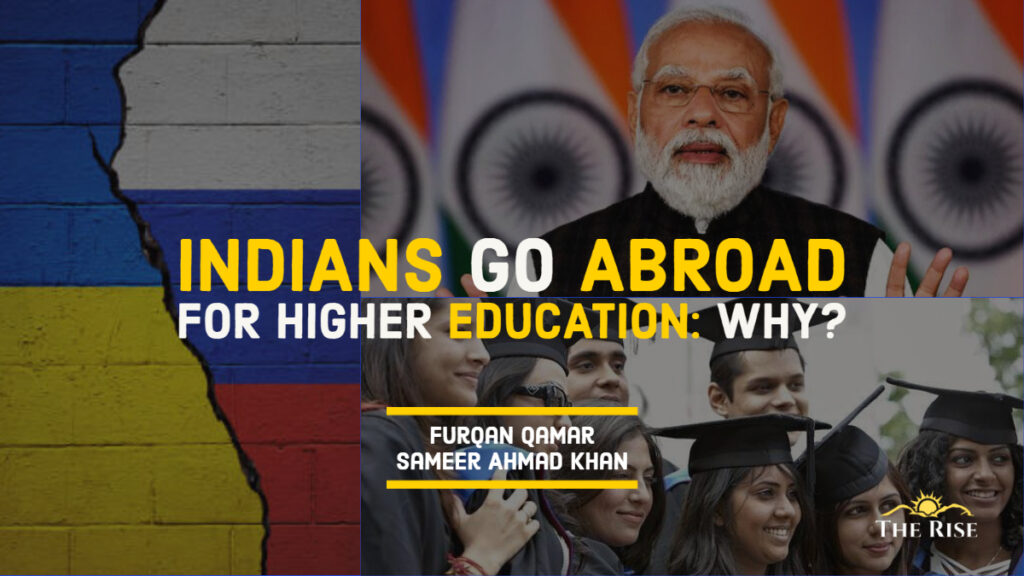Against the backdrop of the Russia-Ukraine crisis, the Prime Minister of India has revived a concern that needs to be taken seriously and urgently. It is imperative for the higher education policy planners, administrators, and regulators to take proactive measures to ensure quality higher education at an affordable cost within the country across the broad spectrum of higher education, including but not limited to only medical education.
It was deeply distressing to see the Prime Minister of India anguished about a large number of Indian students going abroad for higher education, particularly medical education, to even smaller countries with alien languages putting themselves to a lot of inconveniences and also causing a drain of billions of foreign exchange. The concern gets further aggravated also on account of the quality of medical education that these students receive in many of the new generation destinations, like Ukraine, and warrants serious brainstorming.
Speaking of the MBBS, the undergraduate programme in medical education, India has a total of 595 medical colleges, comprising 302 government, 218 private, 47 deemed universities, 3 central universities, 19 All India Institutes of Medical Sciences (AIIMS), and 2 Jawaharlal Nehru Institutes of Postgraduate Medical Education and Research (JIPMER). Put together, they presently have a total intake capacity of 88,370 with 44,555 in the governmental sector and 43,815 in the private medical colleges. Admission to these seats is granted on the basis of scores obtained by students in the National Eligibility cum Entrance Test (NEET) conducted annually by the National Testing Agency (NTA) of the country. Over the period of time, while the demand for medical education has been increasing, as manifested by the number of applicants for NEET, the intake capacity has not been able to keep pace. As a consequence, the demand-supply gap has been widening, thus making chances of securing admission slimmer with each passing year.
In 2021, for example, as many as 15.44 Lakh candidates appeared for NEET. The number this year was 12.97 percent higher than 2020. Given that only 88,370 could be selected for admission to the MBBS programme, the unmet demand for medical education has been huge. Further, quite a few of the candidates who secured enough scores to become eligible to get admission in the private medical colleges often drop out of the race due to hefty fees and look for opportunities elsewhere.
Also Read: Brain Drain: An Apparent Loss to the Nation May Prove Lasting Gain to the Profession
Incidentally, only a minuscule proportion of those who either could not make the NEET cut-off or dropped out look for medical education abroad as only about 10,000 students go overseas for the purpose annually. The National Board of Examination (NBE) lists 59 countries where Indian students get their MBBS degrees from, the most popular destinations being Nepal, Bangladesh, Sri Lanka, Russia, Ukraine, China, and the Philippines.
An MBBS degree in private colleges in India may, on an average, cost Rs. 50 to 60 Lakh whereas in countries like Ukraine and Russia it could cost as little as Rs. 19 and 19.4 Lakh, respectively.
Amongst the many reasons that could be attributable to pursuing medical education abroad, ease of admission and cost-effectiveness appear to top the list. The cost of getting an MBBS degree in some of these new generation destinations is considerably lower than those charged by the private medical colleges in India. An MBBS degree in private colleges in India may, on average cost Rs. 50 to 60 Lakh whereas in countries like Ukraine and Russia it could cost as little as Rs. 19 and 19.4 Lakh respectively.
The ease of getting admission is another dominant factor. Most NEET aspirants start “investing” in preparatory coaching to crack the exam long before they even complete their school education. They spend their time and money to get coaching, mock tests, lectures, last-minute notes, and whatnot to get ‘a good rank’ so as to secure a seat in a medical college in India, indeed a stressful process not just for the aspirants but also for the parents. In contrast, getting admission abroad is comparatively a hassle-free process. With relaxed academic requirements and little to no competition, it’s a piece of cake to secure a seat in such places. Better quality of education, infrastructure, global ranking, and exposure – all contribute to foreign lands becoming a hotspot for MBBS students.
But the lower cost and ease of admission come at a huge risk. It is now mandatory for all students desirous of pursuing their medical degree abroad to appear in the UG NEET examination. After completion of their MBBS, they must qualify for the Foreign Medical Graduate Examination (FMGE) to be able to practice in India. The only exceptions are those who have completed their medical degree from the UK, USA, Australia, Canada, and New Zealand.
Better quality of education, infrastructure, global ranking, and exposure – all contribute to foreign lands becoming a hotspot for MBBS students.
NBE data indicates that close to 84 percent of the doctors failed to qualify FMGE test during the last 7 years. In December 2021 itself, 23,691 students appeared for FMGE, of which only 5,665 could qualify to get the license to practice medicine in India. During the past five sessions, the FMGE pass percentage has never crossed 25 percent. This is despite the fact that FMGE does not follow negative marking and is only a qualifying exam requiring students to score a minimum of 50 percent marks. This comments adversely on the quality of medical education that these students get abroad.
Those unable to qualify for the exam, however, blame the NBE for being ‘too tough’ or for lacking in transparency. The reasons may however be multifaceted. The syllabus taught abroad is not the same as followed in India. Forensic medicine, for example, is a mandatory component of a medical degree in India but is not taught elsewhere. This forces foreign graduates to spend additional time and resources on coaching to learn this when they are back in India. Most of the time, students with medical qualifications abroad are compelled to re-do a good portion of the syllabi before they appear in FMGE. Imagine asking conceptual questions based on 19 subjects that you had studied over five years. And at last, the difficulty level of the paper is said to be much higher than those at the local level. This is the reason why even those who qualify take multiple attempts to do so.
World Health Organisation (WHO) recommends a doctor-patient ratio in a country to be 1:1000, which India claims to have already accomplished. Minister of State (MoS) Health has gone on record during the winter session of the Parliament that India, with 13 lakh medical practitioners has achieved this golden ratio as it now has 1 doctor for every 834 patients (1:834). Some, however, disagree with the numbers as they feel that the figure is based on the Indian Medical Registry which contains the names of practitioners who have died, retired, migrated, or stopped practicing. The real numbers are not even remotely close. Experts estimate that 1 doctor for every 2000 patients is a reasonable estimate of what we have accomplished so far. Besides, the WHO norm is the minimum desirable number. Obviously, India needs to further enhance the intake capacity in medical education. At the same time, making equitable access through affordability would also be a sine qua non.
Why is India Unable to Attract International Students?
The internationalization of higher education and its implications are not confined to medical education alone and are manifested across the broad spectrum of higher education.
National Education Policy (NEP 2020) strives to ‘restore the role of India as Vishwa Guru by promoting India as a global study destination by offering premier education at an affordable cost’. Furthering the policy, UGC in its 2021 guidelines, inter alia too seeks to make India an attractive destination for foreign students. The Study in India (SII) launched in 2018 had targeted to raise the number of international students in the country to 200,000, of which 18000 were to be taken in the very first year. It could however attract only about 2000. Similar was the experience with the Promotion of Indian Higher Education Abroad (PIHEAD) launched in 2004.
Also Read: Internationalization of Indian Higher Education
At the policy front, higher educational institutions in India are permitted to admit international students, on a supernumerary basis, to the extent of 15 percent of their intake capacity. Given the fact that the country has 38.5 million students in higher education, the total potential of the country works out to be 5.78 million international students. Since globally only as many students leave their homes for higher education abroad, it would be naive to assume that India would ever be able to attract all of them to its shores. India could, however, target at least a 20 percent share in the higher education export market. This would work out the realizable potential of 1.12 million. In comparison, currently, the country has only 49,358 international students, thus actualizing only 4.41 percent of its realizable potential.
World’s largest system of higher education in terms of the number of higher educational institutions, and the second largest in terms of enrolment, has not been able to attract a larger number of international students.
It is puzzling that the world’s largest system of higher education in terms of the number of higher educational institutions and the second largest in terms of enrolment, has not been able to attract a larger number of international students impressing upon the need to have a realistic look at the assumptions that guide our aspirations to become a global hub for higher education. Our ambition to attract a large number of international students is based on two major assumptions.
The first being the belief that our higher educational institutions are globally recognized for their quality as manifested by the fact that Indian students going abroad either for further studies or for jobs are generally regarded as fundamentally stronger, hard-working, keen learners, creative and result-oriented.
Also Read: New Education Policy 2020 – Implementation Challenges in Higher Education
The ground reality, however, belies this assumption. India may have been the Vishwa Guru in its ancient past and may have the potential to become one in the future bu,t as of now, very few of our higher educational institutions are known for offering quality higher education. These include the top 100 NIRF (National Institutional Ranking Framework), the A or A+ accredited institutions by NAAC (National Assessment and Accreditation Council), and those appearing amongst the top 500 in any one of the world university rankings – ARWU, THE, and QS. Taken together, they are no more than 150. These institutions enroll no more than a million students in higher education with a total potential to have no more than 150,000 international students. This constitutes the real potential of the country as far as International students are concerned.
The country is thus able to attract only a third of its real potential. There could be only two plausible reasons for the same. Firstly, the quality higher educational institutions in the country are quite selective and have a high to very high demand ratio or least to application ratio. Consequently, many international students, particularly those from Asian and African countries, find it difficult to come up to marks on admission criteria. Additionally, our best higher educational institutions are still nowhere close to the best or even the average of the higher educational institutions in the developed countries, which would essentially mean that even the best of our higher educational institutions are unable to attract the best international students.
You May Like: Excess Impedes Excellence: Empirical Evidence for Regulation in Higher Education
The second assumption rests upon the belief that India can provide comparable quality of higher education at an affordable cost because it has a comparative cost advantage. This assumption is reinforced by the fact that India offers higher education at a much lower cost.
An analysis of the data from the 115 higher educational institutions empanelled on the SII portal indicates that the fees chargeable from international students averages at about $8000 per year, though quite a few institutions charge no more than $1,511 per student. Some institutions, however, do charge higher fees ranging from $25,303 to $35,660 per annum. A quick scan of the admission brochures of higher educational institutions, in general, shows that they charge between $1000 to $10,000 per annum with most charging between $2000 to $3000. Going by the SII portal the ‘Cost of Living’ in India is 66.85% lower than in the United States; further Rent in India is 83.28% lower than in the United States. Accommodation costs or hostel fees range from $700 to $2000 on an annual basis – a cumulative analysis of the average expenditure of studying and living in India ranges between a bare minimum of $2500 to (a little over) $6000’.
Improving the overall quality of higher education across the board, and helping students finance a major portion of their educational expenses are critical to attracting international students to India.
These do indicate the comparative cost advantage that India has as compared to the major destinations of higher education for international students. This advantage is, however, lost on account of the fact that India does not provide on-campus or off-campus job or income opportunities to the international students thereby requiring them to meet the total cost of their education and living expenses through remittances from their home countries, with ICCR (Indian Council for Cultural Relations) sponsored international students being a major exception.
In contrast, the major destinations for international students provide ample opportunities for teaching and research assistantship, off-campus and on-campus income opportunities to help students meet a significant proportion of their cost of education and living expenses through their earnings in those countries themselves.
In conclusion, unless we improve the overall quality of higher education across the board and in a substantial number of higher educational institutions, and help students finance a major portion of their educational expenses, the number of international students in India is likely to remain low, aspirations notwithstanding.
Also Read: Gurus Being Outsourced in ‘Vishwaguru’ India
Obviously, so far we as a country have neither been as successful in export promotion nor import substitution as far as general, professional, and technical higher education is concerned. The Prime Minister has revived the concern that needs to be taken seriously and urgently. It is imperative for the higher education policy planners, administrators, and regulators to take proactive measures to ensure quality higher education at an affordable cost within the country across the broad spectrum of higher education, including but not limited to only medical education.
Disclaimer: The views expressed in this article are of the authors solely. TheRise.co.in neither endorses nor is responsible for them.











































Pingback: Why do Indians go Abroad for Higher Education? – Furqan Qamar
Pingback: Expansion in Medical Education: Easier Said Than Done - TheRise.co.in
Pingback: Academic Collaboration of Indian and Foreign Institutions - TheRise.co.in
Pingback: The New Geopolitics Of Global Education - TheRise.co.in
Pingback: Protectionist UK Restricting Indian Students May Backfire
Pingback: Exam Failures and Crisis in Indian Education - TheRise.co.in